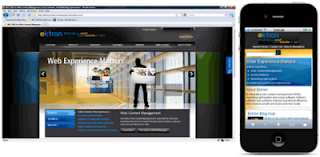The mobile web is coming…
The mobile web is here…
Why isn’t your site mobile friendly?
The truth is, as much as we all know as marketers and technologists that we need to embrace mobile as a platform, most of us still aren’t quite sure how to do it. And so it sits in our pile of projects, never really getting the attention it needs – and deserves.
And with each passing day, building a mobile web presence continues to further transform from a ‘nice to have’ to a necessity, so if you haven’t already, developing a strategy for how you are going to embrace mobile devices has to be first and foremost on your marketing agenda.
THE BASICS
Even if you don’t own a smart phone (and seriously, who doesn't these days!), just about everyone has had a chance to play with an iPhone, Blackberry, Android, iPad, etc., and seen the power these devices can deliver.
 Whether it’s allowing a user to get directions to one of your stores, allowing a worker to reorder a part while he’s standing next to the machine in the warehouse, or allowing prospective clients to learn about your products while sitting on the train, the possibilities are endless. The key is to identify how your users are using your current website, and how those trends translate to the mobile universe.
Whether it’s allowing a user to get directions to one of your stores, allowing a worker to reorder a part while he’s standing next to the machine in the warehouse, or allowing prospective clients to learn about your products while sitting on the train, the possibilities are endless. The key is to identify how your users are using your current website, and how those trends translate to the mobile universe.WHERE TO BEGIN
Ask yourself this question: “if I was a customer/user/student/member interested in your organization/company, why would I come to your website?”
Think about the context in which the user is coming to the website. What types of tasks do they routinely perform? Information gathering? Online ordering? Accessing private/member’s only content? Thinking about the context of potential visits will help in developing your actual strategy.
In its simplest form, ask yourself “why would someone look at my website on their smart phone or tablet” and you’ll be off and running.
NEXT STEPS
Once you’ve identified the types of interactions that a user will have with your site, start by cataloging and evaluating your current web content to see which types of content it makes sense to expose for mobile viewing. Not every page of your website needs to be ‘mobilized’ – though that certainly is an option.

When your content inventory is complete, you should be able to then build an information architecture and navigation strategy for your mobile site. With a mobile device, so often the menu system really is the site, so making it clear, concise, and easy to navigate is essential.
From there, identify the platform that’s going to help you deliver web content. Tools like Ektron CMS400.NET have a mobile framework built-in to support multi-channel messaging.
You’ll want to make sure whichever solution you go with offers:
- Support for all mobile devices (phones and tablets, and only God knows what else is coming)
- Includes automatic device detection (the ability to automatically determine which device a user is using so that it can render the appropriate display/content)
- The ability to determine whether you want a granular approach (content specific for each individual device) or the ability to setup groups of devices (smart phones, tablets, etc.), that make it easier and more efficient to deploy your first generation mobile site
In short, building a mobile strategy is nothing to be afraid of. In fact, there is such a high level of cool factor (partially because it is taking some time to get adopted by SMB and mid-market entities) that you’ve got an opportunity to be the first among your competitors to start benefiting from a mobile presence.
Think of the difference in your market when a competitor introduced eCommerce first and you watched your sales go to them because of the ease of the transaction and initial coolness of being able to order online? You’ve got a chance to make that same kind of impact with mobile, but you better act fast.
Analysts predict that by 2012, mobile devices will be the most popular internet browsing device, surpassing PCs. The question is, will users be able to browse your website in a mobile-friendly manner? I sure hope so.
Enjoy what you just read? Think this guy couldn’t be more off his rocker? Leave a comment below and help influence future entries.